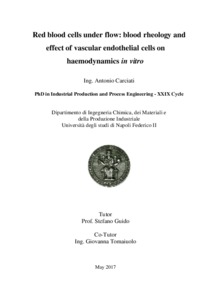Carciati, Antonio
(2017)
Red blood cells under flow: blood rheology and effect of vascular endothelial cells on haemodynamics in vitro.
[Tesi di dottorato]
![[img]](http://www.fedoa.unina.it/11631/1.hassmallThumbnailVersion/Red%20blood%20cells%20under%20flow%20blood%20rheology%20and%20effect%20of%20vascular%20endothelial%20cells%20on%20haemodynamics%20in%20vitro%2C%20Antonio%20Carciati.pdf)  Anteprima |
|
Testo
Red blood cells under flow blood rheology and effect of vascular endothelial cells on haemodynamics in vitro, Antonio Carciati.pdf
Download (5MB)
| Anteprima
|
| Tipologia del documento: |
Tesi di dottorato
|
| Lingua: |
English |
| Titolo: |
Red blood cells under flow: blood rheology and effect of vascular endothelial cells on haemodynamics in vitro |
| Autori: |
| Autore | Email |
|---|
| Carciati, Antonio | antonio.carciati@unina.it |
|
| Data: |
Maggio 2017 |
| Numero di pagine: |
101 |
| Istituzione: |
Università degli Studi di Napoli Federico II |
| Dipartimento: |
Ingegneria Chimica, dei Materiali e della Produzione Industriale |
| Dottorato: |
Ingegneria dei prodotti e dei processi industriali |
| Ciclo di dottorato: |
29 |
| Coordinatore del Corso di dottorato: |
| nome | email |
|---|
| Mensitieri, Giuseppe | giuseppe.mensitieri@unina.it |
|
| Tutor: |
| nome | email |
|---|
| Guido, Stefano | [non definito] | | Tomaiuolo, Giovanna | [non definito] |
|
| Data: |
Maggio 2017 |
| Numero di pagine: |
101 |
| Parole chiave: |
Human blood rheology, haemodynamics, RBC, vascular endothelial cells, malaria |
| Settori scientifico-disciplinari del MIUR: |
Area 09 - Ingegneria industriale e dell'informazione > ING-IND/24 - Principi di ingegneria chimica |
[error in script]
[error in script]
| Depositato il: |
25 Apr 2017 17:09 |
| Ultima modifica: |
08 Mar 2018 13:40 |
| URI: |
http://www.fedoa.unina.it/id/eprint/11631 |
| DOI: |
10.6093/UNINA/FEDOA/11631 |

Abstract
Understanding rheological properties and flow behavior of human blood is the object of a large body of literature related to both biomedical and clinical field of cardiovascular disorders as well as to the development of microfluidic platforms for blood testing. Although hemorheology and haemodynamics would seem to have the potential to describe complex physiological phenomena, there is still uncertainty regarding the exact applicability to specific issues.
Here, an extensive rheological characterization under both continuous and oscillatory conditions is presented, demonstrating that human blood shows a peculiar viscoelastic behavior. In particular, the viscous character prevails over the elastic one even if the latter gives a significant contribution to the mechanical spectra. In addition, the effects of increasing red blood cells (RBC) volume fraction and of the addition of dextran, an aggregating agent, has been studied, showing a gel-like response.
Regarding haemodynamics, blood flow in human body shows uncommon phenomena compared to other fluids. In vitro models that mimic human vasculature and the study of the interaction between endothelial cells and RBC are the main topics which have not been deeper investigated. Moreover, the properties and the role of endothelial glycocalyx (GCX), a negatively charged hairy layer of proteoglycans and glycoproteins located on the inner surface of the vascular endothelium, is far from being fully elucidated.
In this work, the study of blood flow in microchannels lined with endothelial cells, including the GCX, has been proposed. Microchannels dimensions and flow conditions have been chosen to mimic big arterioles and venules regions. Velocity profiles of RBC in endothelialized microchannel have been compared with bare ones, suggesting a marginal role of the endothelial layer. Moreover, the electronegativity of endothelial GCX seems not to influence RBC flow. A case study that uses the mentioned approach is addressed to the analysis of malaria infected RBC by Plasmodium falciparum parasite. Indeed, the pathogenicity of Plasmodium parasite results from its ability to adhere to endothelium during its life cycle, preventing removal by the spleen. Preliminary results regarding dynamics of a single RBC are in good agreement with previous numerical simulation works, while the cytoadhesion has shown that both healthy and infected RBC adhere on endothelial cells.
These findings could be useful for a deep understanding of the human blood flow behavior. In particular, viscoelastic characterization could help in elucidating the role of hemorheological alteration in pathologies such as myocardial infarction, hypertension, and diabetes. On the other hand, RBC-endothelial cell flow assay can serve as starting point to design blood-on-chip platforms aimed to study drug transport in blood stream.
Downloads per month over past year
Actions (login required)
 |
Modifica documento |





